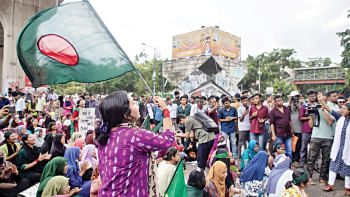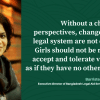How literature can dismantle patriarchy in Bangladesh and beyond

"One is not born, but rather becomes, a woman." — Simone de Beauvoir
"Can the Subaltern Speak?" — Gayatri Spivak
The prevalence of gender-based violence, particularly rape, in Bangladesh is not an isolated crisis but a symptom of entrenched patriarchy reinforced by sociopolitical and economic structures. As Simone de Beauvoir asserts in The Second Sex (1949), "One is not born, but rather becomes, a woman," underscoring that gender is a social construct shaped by norms that normalise women's subjugation and erasure. Economic instability, unemployment, and widening wealth inequality intensify social tensions, while political dysfunction and weak governance foster impunity. A corrupt and lethargic justice system obstructs legal recourse, ensuring that crimes go unpunished. Despite periodic media attention, meaningful reforms remain elusive as society cycles through selective outrage and apathy, deferring urgent change.
A literary-critical lens offers an incisive way to examine how patriarchal violence is sustained, resisted, and reimagined. Literature does not merely reflect reality; it constructs and deconstructs the narratives that shape societal attitudes toward gender. Texts that expose female suffering—such as Faulkner's As I Lay Dying, Gilman's The Yellow Wallpaper, and Nasrin's Lajja—lay bare the silencing of women and the structures that uphold their subjugation. Others, like Hossain's Sultana's Dream, disrupt patriarchal conventions by envisioning alternative realities where women reclaim agency. These literary interventions illuminate both the pervasiveness of patriarchal violence and the radical potential of literature to critique and dismantle oppressive systems.
In Bangladesh, as across the Global South, gender-based violence is deeply embedded in familial, societal, and institutional structures. Domestic abuse, dowry-related violence, sexual harassment, and rape persist, with survivors constrained by economic dependence, social stigma, and institutional neglect. When women seek justice, they encounter not only bureaucratic inertia but active hostility—from law enforcement, the judiciary, and a society conditioned to silence them. This emboldens perpetrators and reinforces a culture of impunity.
Yet, misogynistic patriarchy is not merely a national affliction—it is a global system of subjugation, transcending borders, race, religion, and class. It operates through institutional mechanisms and cultural narratives that justify women's suffering, whether through overt brutality—domestic violence, honour killings, femicide—or the more insidious forms of oppression that erase their autonomy and silence their resistance.
By situating literary works within this larger socio-political framework, a literary-critical approach exposes how patriarchal violence is both narrated and contested. Literature becomes not only a means of documenting oppression but a crucial site of resistance—where silenced voices speak, and where the structures of gendered violence are scrutinised, destabilised, and reimagined.
Literature as a lens on the global grip of patriarchy
Literature has long served as both a mirror and a weapon against patriarchy, exposing its systemic violence, silencing, and subjugation of women across cultures and histories. Gendered oppression is not incidental—it is woven into the very fabric of social, political, and economic structures. Through fiction, poetry, and drama, writers have laid bare the mechanisms of misogyny—its moral hypocrisies, its brutalities both overt and insidious, and the ways it reinvents itself to preserve dominance. These narratives do more than document oppression; they resist it, giving voice to those silenced by history and demanding a reckoning with entrenched power.
Western literary traditions abound with critiques of patriarchal violence. Anton Chekhov's A Journey by Cart reveals the casual neglect and dehumanisation of women in a society where their suffering is normalised. William Faulkner's As I Lay Dying portrays a mother's body becoming mere baggage, a haunting metaphor for the disposability of women's lives. Thomas Hardy's Tess of the d'Urbervilles exposes the moral hypocrisy that condemns a woman while absolving the man who ruins her. Charlotte Perkins Gilman's The Yellow Wallpaper unpacks the patriarchal medical establishment's control over women's minds and bodies, while Margaret Atwood's The Handmaid's Tale extends this critique to a dystopian extreme, revealing how state control over female reproductive rights is a logical extension of historical oppression.
Bangladeshi literature, in turn, deepens and expands these concerns by situating gendered oppression within the specific contexts of war, nationalism, and economic disparity. Authors like Selina Hossain, in Hangor, Nodi, Grenade, and Shaheen Akhtar in Talaash, document the brutal sexual violence inflicted on women during the Liberation War of 1971—an event often sanitised or marginalised in nationalist narratives. Hasan Azizul Haque and Akhtaruzzaman Elias expose the intersections of class, patriarchy, and state violence, showing how women's bodies become battlegrounds for larger political struggles.
Beyond Western and South Asian canons, postcolonial literature reveals how colonialism and patriarchy reinforce one another, entrenching gendered violence within broader structures of domination. Buchi Emecheta's The Joys of Motherhood interrogates the contradictions of motherhood as both a source of fulfilment and a mechanism of subjugation in a patriarchal and colonial order. Tsitsi Dangarembga's Nervous Conditions explores the tensions between education, autonomy, and tradition in a society where women's aspirations are constantly thwarted. Mahasweta Devi's Draupadi lays bare the brutal realities of state violence against indigenous women, exposing rape not as an individual crime but as a tool of systemic oppression.
Literary/critical lens as a site of resistance: Toward gender equity
Patriarchy, a system that dehumanises both women and men, demands not just deconstruction but complete dismantling. Literature serves as a powerful site of resistance, critiquing patriarchal structures and reimagining gender relations. Écriture féminine (women's writing), a concept introduced by French feminist Hélène Cixous, plays a crucial role in this literary resistance. It emphasises a unique form of writing that embraces fluidity, emotion, and the body—rejecting rigid, patriarchal structures in favour of expression that celebrates women's experiences and perspectives. This writing style allows for the creation of texts that break free from patriarchal constraints, offering alternative narratives where women's voices are central.
The theories of Gayatri Spivak, Judith Butler, and Elaine Showalter provide further insights into the complex dynamics of patriarchy and its impact on women's voices. Spivak's seminal question, Can the Subaltern Speak?, highlights how women, particularly those from marginalised groups, are rendered voiceless by patriarchal and colonial structures. Butler's theory of gender performativity challenges the notion of fixed gender identities, arguing that gender is a social construct enacted through repeated behaviours and practices. Elaine Showalter's work on the internalised patriarchal gaze emphasises how patriarchal structures not only oppress women externally but shape their internal worlds, making them complicit in their own subjugation.
In a postmodern world where truths are fractured and identities fluid, breaking the cycle of misogynistic patriarchy in Bangladesh demands more than legal reforms. It requires a cultural rupture—education, media, and institutions must expose the constructed nature of gender roles and the violence they perpetuate. Literature, as a space for deconstructing these myths, challenges us to reimagine gender relations and empower women as agents of change, rather than passive victims.
True gender equity demands dismantling the entire structure of patriarchy, not only for women but also for men, who are equally trapped in rigid roles. Postmodern justice is not about restoring a singular truth but embracing multiplicity—recognising that the moral integrity of a society is measured by how it redefines power and solidarity. Only by rejecting the totalising structures of patriarchy can Bangladesh, together with the rest of the world, move toward a future where equality is lived and not just dreamed.
Dr Faridul Alam is former faculty member at the City University of New York (CUNY) and a licensed social work practitioner. He writes full-time on interdisciplinary issues, primarily through the lenses of postmodernism and postcolonialism.
Views expressed in this article are the author's own.
Follow The Daily Star Opinion on Facebook for the latest opinions, commentaries, and analyses by experts and professionals. To contribute your article or letter to The Daily Star Opinion, see our submission guidelines.

 For all latest news, follow The Daily Star's Google News channel.
For all latest news, follow The Daily Star's Google News channel. 









Comments